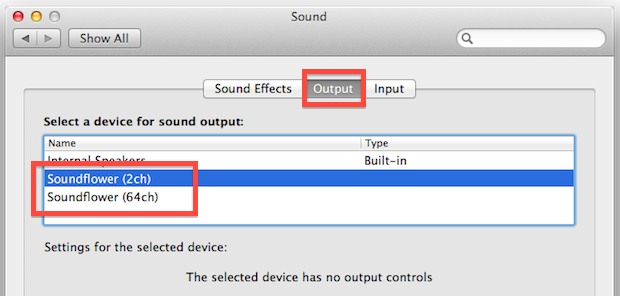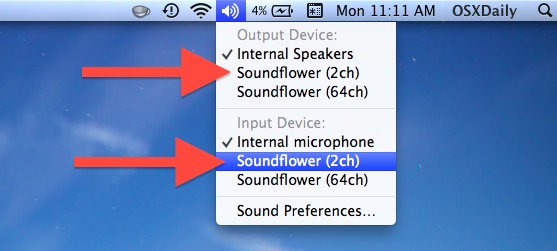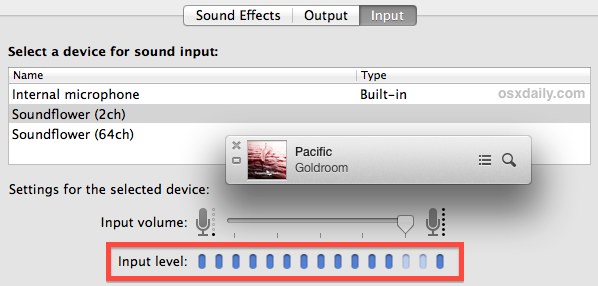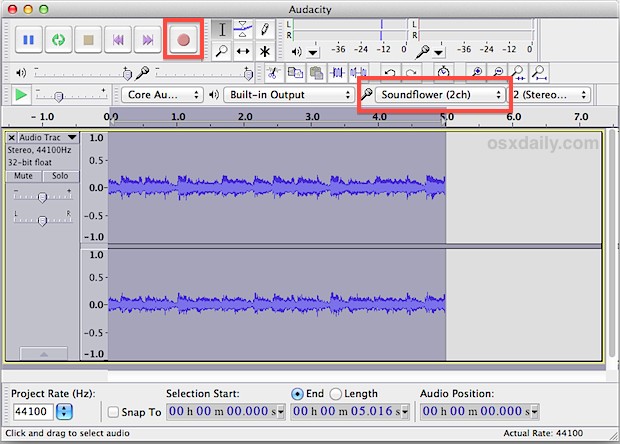Record System Audio Output in Mac OS X with Soundflower
Capturing system audio on a Mac is not something that OS X has the native ability to be able to perform, but with the help of a great third party utility you can easily add that functionality to Mac OS X and any accompanying applications. This means you can capture and record audio output directly from anything that is playing on the Mac, whether that’s from apps like iTunes, Garageband, Spotify, or even just a web browser like Safari or Chrome.

Indeed there are other apps and microphone accessories that allow for the same type of sound capturing functionality, but Soundflower has a few distinct advantages: it’s free, it’s lightweight, it’s super easy to install, and it’s even easier to use, plus it also allows for additional advanced options like setting a system-wide equalizer for all audio output on a Mac.
Redirect System Audio with Soundflower
Soundflower is required to be able to send audio output channels into the audio input.
- Download Soundflower (free)
- Mount the DMG and install Soundflower, then reboot the Mac to complete installation
- Pull down the Apple menu and open System Preferences, then go to “Sound”
- Under “Output” select “Soundflower”
- Next, under “Input” tab, again select “Soundflower” (for testing purposes, adjust this later for your own needs on a per application basis)

Setting Soundflower to both output and input gives a direct line from system audio output to system audio input, but you can obviously adjust those settings as appropriate for your needs.

Once Soundflower has been installed, you can also quickly adjust audio input and output by option+clicking the Volume menu and selecting Soundflower as the audio input, output, or both from there too.

A quick way to test and confirm that Soundflower is working is if you start playing system audio with Soundflower now set as both input and output sources. Start playing any audio, then look within the Input tab of Sound prefs to find the “Input Level” indicator is moving to the sounds of the the system audio which is now being transported through Soundflower, rather than the general output speakers and input microphone.

The brief video below demonstrates audio channels being redirected from iTunes through Soundflower, which are then able to be picked up by the screen recording application QuickTime:
Notice how the audio will cut in or out depending on which output setting is chosen.
Recording System Audio Output with Soundflower
At this point you are able to record any system level audio output using whichever app is appropriate. Keep in mind that most audio recordings are subjected to their own usage and rights laws, each of which will probably differ depending on the owner and distributor of the audio. Be sure to check those rights before capturing audio. Nonetheless, all you’ll need to do to capture audio output is to select Soundflower as the sound channel(s) when capturing audio using whichever app you are using, whether it’s Garageband or something like the freeware Audacity app. We’ll walk through how to record any audio with Audacity:
- Download Audacity (or use another app)
- Option-Click the Volume menu and send Output to “Soundflower”
- Launch Audacity and change the audio input to “Soundflower”
- Start playing the audio you wish to capture
- Click the red “Record” button in Audacity to start capturing the playing audio, click “Stop” or “Pause” when finished
- Play back the audio to find whatever the output was is now perfectly captured

It really is that simple.
There are two important things to remember when recording audio output with Soundflower that will apply to any application you use to capture audio:
- Always set the System-level Audio Output to “Soundflower”
- In the recording application, always select the Audio Input (microphone setting) to “Soundflower”
You can use either Soundflower 2channel or Soundflower 64 channel, just be sure to match them up for both audio input and output.
Uninstalling Soundflower
Uninstalling Soundflower is just a matter of remounting the DMG again, then running the “Uninstall Soundflower.scpt” file that resides there. If you tossed the original installation .dmg, download it again and you’ll be able to find the uninstaller.


You saved me yet again. Much appreciated.
download newest version of soudflower link below:
https://github.com/mattingalls/Soundflower/releases/
helpful guide on video Link below:
https://www.youtube.com/watch?v=8IQNhXWaaO0
Thank you very much!
Why is the 16 channel version unavailable now? They seem to only let you use 2 or 64 channels, and the 64 channel version busts my audio (even with a huge buffer size).
I’ve used Quicktime to recordmy screen and told it to record Soundflower, but the audio has multiple echo’s.
Any tips?
The download link for Soundflower on this post is out of date. To get the current version, check here: https://rogueamoeba.com/freebies/soundflower/
Go to QuickTime -> File -> New Screen Recording
Beside the record button there is a drop down icon… Click that and select Built in Mic…
Is there a way to record output at the same time as input?
Nobody’s mentioned Audio Hijack.
I use this with good results and it has a great shortcut (cmd/r) and no matter what program I’m using if Audio Hijack is open and I hit the shortcut Audio Hijack will record whatever is playing. I don’t think it was free (I’ve had it a long time and I think I paid for it)
The only drawback is if I try to refresh a web page using cmd/r and Audio Hijack is open it starts recording and the web page doesn’t refresh
when ii have sound flower as output, i can not hear output sounds, can i both record sound and hear it at the same time?
Same issue,
i can not hear output sounds too when sound flower is active.
how can i hear sound with sound flower ?
I have found it:
“Launch the Soundflowerbed application (found in /Applications/Soundflower). Click the Soundflowerbed menu bar item that appears and choose your speakers or headphones from the menu. Now, not only will your audio application capture what your Mac plays, but you’ll be able to listen to the source audio as well. (You may want to do this before setting up QuickTime or GarageBand to capture your audio, but that’s up to you.)”
From this step 4 : http://www.macworld.com/article/1159440/soundflower_capture.html
https://osxdaily.com/2013/02/25/record-system-audio-mac-os-x-soundflower/
Enjoy :)
On a Mac OSX computer, you can create an aggregate device (combines multiple audio interfaces into “1” audio interface). Located in Finder/Applications/utilities/Audio MIDI Setup.
I had Soundflower installed, as a requirement for AirFoil 3.x
I feel it was worth having and didnt’ notice any CPU melting or RAM hogging tendencies? I’ll try this tip for recording audio when the need arises, thanks.
Forgot to mention, it’s worth having SoundFlower as an optional system-wide EQ.
AFAIK, iTunes and Spotify don’t make equalizer options readily available?
I installed SoundFlower. Then, when I need to make a screen recording with Quicktime, I choose SoundFlower for the audio input in Quicktime and SoundFlower for the system”s audio output. It works really well.
You don’t really need Soundflower. Just use Screenflow, and before you hit that record button just check system recording and uncheck video.
Ugh, Audacity is so ugly and hard to use.
I prefer MicroWave (from the mac app store).
did you consider Piezo?